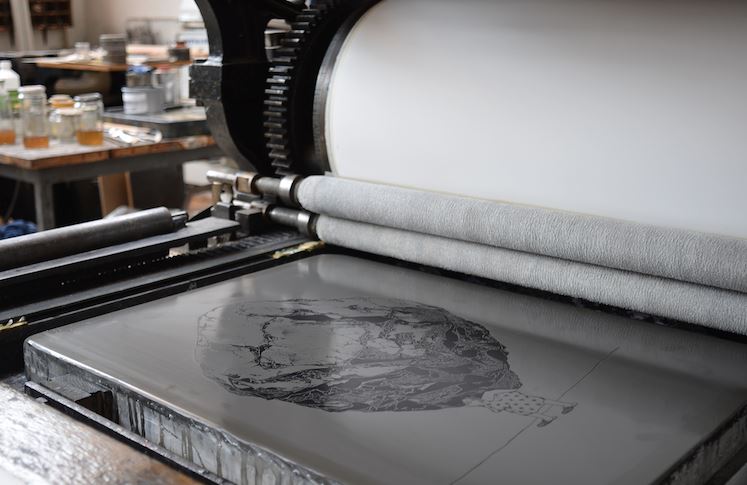
What Is a Lithograph? How to Make a Lithograph
Jan 31, 2024 By Frederica
The primary reason why you ended up in this article is probably because you heard about lithographs and wanted to know more. Well, lucky for you, you have landed on the right page.
Lithography is an incredible concept; only a few know its different methods and how one can make a lithograph. If you want to enlighten yourself on this topic, we suggest you keep reading all that we concluded below. Let’s dive into the article!
What is a Lithograph?
A lithograph is a piece of art that includes drawing an image on a lithographic plate and then treating it with an acidic solution and water. After this, it is eventually stamped onto a sheet of paper. This surface repels water and attracts wax.
Artists cover the treated stone with a particular type of ink after this, which helps create a printed image that the artist can imprint multiple times when pressing it onto numerous sheets of paper using either a roller or tympan.
The Origin of the Lithograph
The origin of lithographs was quite an accident, to be honest. In 1796, a Bavarian playwright, Alois Senefelder, realized that he could make multiple copies of his scripts if he wrote his words on limestone with a greasy crayon and then imprinted those words on paper.
Limestones retain ink well, so Alois could make multiple copies of the same page by repeatedly laying sheets of paper over the surface.
The Five Different Lithographic Methods
Over the past few years, the lithography process has become relatively streamlined to incorporate new and time-saving methods. If you are interested in reading more about it, then we have some of the most popular types of lithographs listed for you below:
Original Stone Lithography

Stone lithography is the original and traditional method of pressing ink into a flat stone to form an etching of an original drawing. In this method, the printers incorporate separate rocks with various colors to make a color lithograph. However, the colors are usually black or white.
Lithographic Reproduction
This method is a photograph of an original artwork piece that an artist transfers onto a photosensitive lithographic plate. The method of poster-making relies on this same process.
Mylar Plate Lithography
This type of lithographic printing uses a sheet of plastic or polyester to hold onto an image. The artist then prints the image onto the photosensitive lithographic printing plate.
Offset Printing
Also known as offset lithography, this method is a mass production printing and illustration technique where the texts and images on metal plates are compensated to a runner blanker or rollers, from where they are then transferred to a paper for printing.
Original Plate Lithography
The plate lithographic process involves using aluminum plates to etch the images. This method is easier and less expensive than stone lithography methods.
How to Make a Lithograph?

A lithograph is a unique printing method, and we are sure you must be intrigued to know how to make one. Well, lithograph requires certain unique materials, and all you must do is follow the simple steps we have mentioned below to make a lithograph for a traditional stone etching method:
Prepare the Surface
The surface you will be working on should be even and leveled. So, for example, if you use natural limestone as a surface, sand down on the stone until your surface is smooth. For any other surface, use the required methods to achieve an even base.
Make your Drawing
To draw an image, one should use a lithographic crayon or any other oil-based drawing tool to make the image you want on the surface you are working on.
Prepare the First Etch
When you have drawn an image that is complete, treat the surface with a particular chemical etch like gum arabic or nitric acid. These chemicals will help stick the drawing to the surface, ultimately absorbing the moisture from the blank areas of the image.
Wash out the Drawing
Once etched, let the stone or the surface you are working on rest for about an hour or so. Once done, use turpentine to wash any remaining grease off the drawing. You should have a faint outline of the original illustration at this point.
Apply the Oil-Based Printing Ink
Now, dampen the stone’s surface with water and apply an oil-based ink onto a leather roller. Then, use the roller and apply the ink to the stone's surface you are working on.
Lay out the Paper
Start by cutting out the paper you need to the correct size to fit over the stone. Then, use a tympan – a unique lithograph pressing board – on top of the paper to press it down with equal pressure across the surface you want. Now, run the stone through the lithographic press to transfer the inked image onto your paper medium. That’s about it!
Wrapping Up!
If you have heard about lithographs and want to learn more about this phenomenal concept, we hope this article was helpful to you. There are multiple classes both online and in person which help users learn this skill, so if you are someone who wants to polish this domain, then we urge you to sign up on one today.
-
 Travel Jan 05, 2024
Travel Jan 05, 2024Kanyakumari Tourism and Travel Guide: Everything You Need to Know
Explore the gorgeous Kanyakumari tourist places and learn more about Kanyakumari tourism including the best hotels.
-
 Health Jan 02, 2024
Health Jan 02, 20248 Best Healthy Teas to Drink
Besides being delicious, the teas help combat diseases, cope with stress, ease physical discomfort, and manage a healthy weight
-
 Travel Jan 05, 2024
Travel Jan 05, 20246 Best Hill Stations near Indore in 2024 with Distance: Everything You Need to Know
Learn about the best hill stations near Indore in 2024 for a rejuvenating holiday in nature’s lap and their distance to decide what's best for you.
-
 Entertainment Jan 31, 2024
Entertainment Jan 31, 2024Avatar: Frontiers of Pandora Review
Explore the stunning World of Avatar Frontiers of Pandora, a new action-adventure game. Experience the beauty and danger of this alien planet.